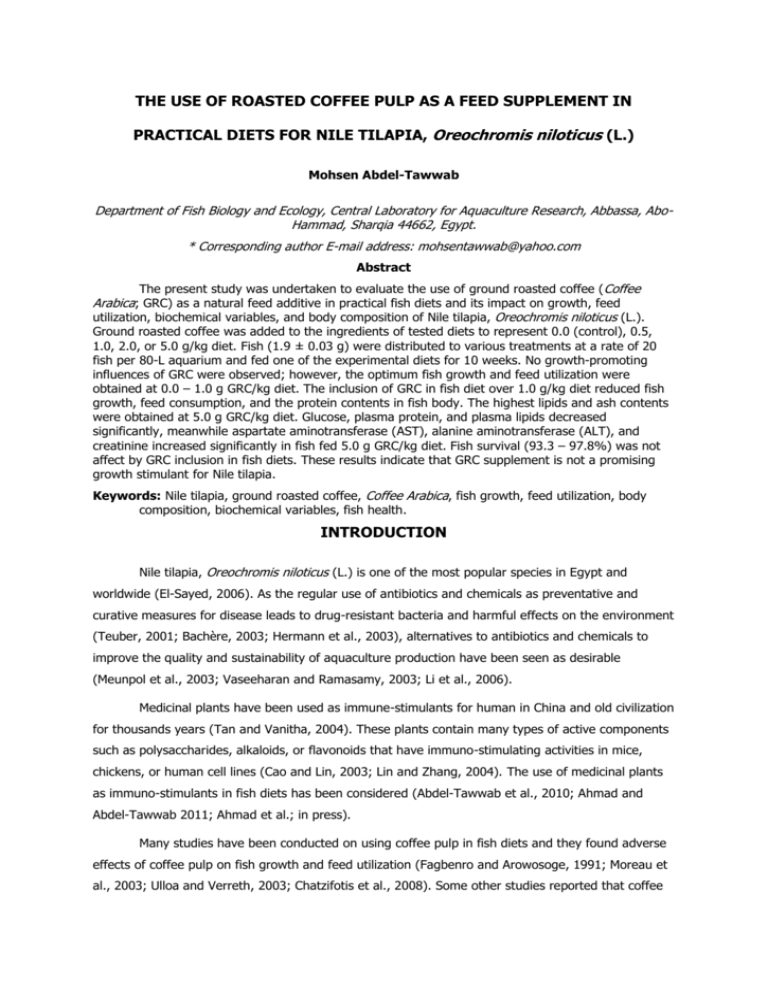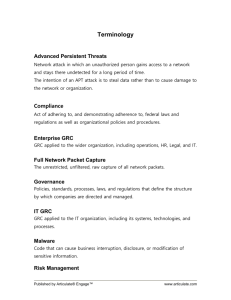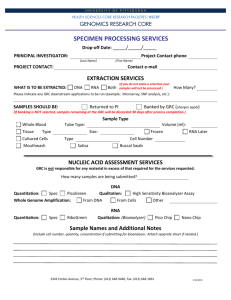the use of roasted coffee pulp as a feed supplement in practical diets
advertisement

THE USE OF ROASTED COFFEE PULP AS A FEED SUPPLEMENT IN PRACTICAL DIETS FOR NILE TILAPIA, Oreochromis niloticus (L.) Mohsen Abdel-Tawwab Department of Fish Biology and Ecology, Central Laboratory for Aquaculture Research, Abbassa, AboHammad, Sharqia 44662, Egypt. * Corresponding author E-mail address: mohsentawwab@yahoo.com Abstract The present study was undertaken to evaluate the use of ground roasted coffee (Coffee Arabica; GRC) as a natural feed additive in practical fish diets and its impact on growth, feed utilization, biochemical variables, and body composition of Nile tilapia, Oreochromis niloticus (L.). Ground roasted coffee was added to the ingredients of tested diets to represent 0.0 (control), 0.5, 1.0, 2.0, or 5.0 g/kg diet. Fish (1.9 ± 0.03 g) were distributed to various treatments at a rate of 20 fish per 80-L aquarium and fed one of the experimental diets for 10 weeks. No growth-promoting influences of GRC were observed; however, the optimum fish growth and feed utilization were obtained at 0.0 – 1.0 g GRC/kg diet. The inclusion of GRC in fish diet over 1.0 g/kg diet reduced fish growth, feed consumption, and the protein contents in fish body. The highest lipids and ash contents were obtained at 5.0 g GRC/kg diet. Glucose, plasma protein, and plasma lipids decreased significantly, meanwhile aspartate aminotransferase (AST), alanine aminotransferase (ALT), and creatinine increased significantly in fish fed 5.0 g GRC/kg diet. Fish survival (93.3 – 97.8%) was not affect by GRC inclusion in fish diets. These results indicate that GRC supplement is not a promising growth stimulant for Nile tilapia. Keywords: Nile tilapia, ground roasted coffee, Coffee Arabica, fish growth, feed utilization, body composition, biochemical variables, fish health. INTRODUCTION Nile tilapia, Oreochromis niloticus (L.) is one of the most popular species in Egypt and worldwide (El-Sayed, 2006). As the regular use of antibiotics and chemicals as preventative and curative measures for disease leads to drug-resistant bacteria and harmful effects on the environment (Teuber, 2001; Bachère, 2003; Hermann et al., 2003), alternatives to antibiotics and chemicals to improve the quality and sustainability of aquaculture production have been seen as desirable (Meunpol et al., 2003; Vaseeharan and Ramasamy, 2003; Li et al., 2006). Medicinal plants have been used as immune-stimulants for human in China and old civilization for thousands years (Tan and Vanitha, 2004). These plants contain many types of active components such as polysaccharides, alkaloids, or flavonoids that have immuno-stimulating activities in mice, chickens, or human cell lines (Cao and Lin, 2003; Lin and Zhang, 2004). The use of medicinal plants as immuno-stimulants in fish diets has been considered (Abdel-Tawwab et al., 2010; Ahmad and Abdel-Tawwab 2011; Ahmad et al.; in press). Many studies have been conducted on using coffee pulp in fish diets and they found adverse effects of coffee pulp on fish growth and feed utilization (Fagbenro and Arowosoge, 1991; Moreau et al., 2003; Ulloa and Verreth, 2003; Chatzifotis et al., 2008). Some other studies reported that coffee shows an antioxidant activity because it contains many substances like caffeine, cafestol, kahweol, and chlorogenic acids (Pellegrini et al., 2003; Vinson et al., 2005). Due to the abundance of antioxidant compounds in coffee, these agents must be seriously considered when elucidating potential pharmacological effects of coffee intake. Therefore, the present research aims to evaluate the effect of ground roasted coffee (GRC) supplementation on growth, feed efficiency, feed consumption, biochemical variables, and proximate composition of Nile tilapia, O. niloticus. MATERIALS AND METHODS Fish culture and feeding regime - Ground roasted coffee (Coffee Arabica; GRC) was obtained from the local market. Five different diets containing 0.0, 0.5, 1.0, 2.0 and 5.0 g GRC/kg diet were formulated. The dietary ingredients were thoroughly mixed and moistened by the addition of 100 ml warm water per kg diet and then made into pellets by a mincing machine. The pellets were cut into shape manually, dried in an oven at 55 oC till constant weight was obtained and stored in a freezer at -2 oC until use. Nile tilapia, O. niloticus were obtained from fish hatchery, Central Laboratory for Aquaculture Research, Abbassa, abo-Hammad, Sharqia, Egypt. Before starting the experiment, fish were acclimated and hand-fed to apparent satiation twice a day for 2 weeks. For the experiment, 15 80-L aquaria were used and oxygenated to saturation by air pumps. In each aquarium, 20 randomly distributed fish (1.9 ± 0.03 g) were stocked. The tested diets were administered to five fish groups with three replicates per each. Fish were hand-fed for satiation thrice daily 5 days a week for 10 weeks. Settled fish wastes along with three-quarter of aquarium’s water were siphoned daily. Siphoned water was replaced by clean and aerated water from a storage tank. Average weight per aquarium was assessed every 2 weeks by group-weighing all fish. Fish were starved for a day before weighing. Fish growth and feed utilization - At the end of the experiment, fish per each aquarium were harvested, counted, and weighed. Fish growth and feed utilization variables were calculated as follows: Weight gain (g) = final weight – initial weight; Specific growth rate (SGR; %/day) = 100 (Ln final weight – Ln initial weight) / days; Feed conversion ratio (FCR) = feed intake (g) / weight gain (g); Protein efficiency ratio (PER) = weight gain (g) / protein intake (g); Fat efficiency ratio (FER) = weight gain (g) / fat intake (g); Energy utilization (EU; %) = 100 x (energy gain / energy intake). Chemical analysis of diets and fish - The proximate chemical analyses of the tested diets and fish samples were done for moisture, crude protein, total lipids, and total ash according to the standard methods of AOAC (1990). Moisture content was estimated by drying the samples to constant weight at 95 oC in drying oven (GCA, model 18EM, Precision Scientific group, Chicago, Illinois, USA). Nitrogen content was measured using a microkjeldahl apparatus (Labconco, Labconco Corporation, Kansas, Missouri, USA) and crude protein was estimated by multiplying nitrogen content by 6.25. Lipid content was determined by ether extraction in multi-unit extraction Soxhlet apparatus (Lab-Line Instruments, Inc., Melrose Park, Illinois, USA) for 16 hours. Total ash was determined by combusting dry samples in a muffle furnace (Thermolyne Corporation, Dubuque, Iowa, USA) at 550 o C for 6 hours. Biochemical measurements - At the end of the 10-week feeding trial, feed was withhold 24 hour immediately prior to sampling and five fish per aquaria were randomly chosen and anesthetized with tricaine methanesulfate (20 mg/L). Blood samples were collected from the caudal vessel and the extracted blood was collected in Eppendorf tubes contained 500 U sodium heparinate/mL; used as an anticoagulant. The collected plasma was stored at –20 oC for further assays. Blood glucose, plasma total protein, plasma total lipids, and plasma creatinine were calorimetrically determined according to Trinder (1969), Henry (1964), Joseph et al. (1972), and Henry (1974), respectively. Activities of aspartate aminotransferase (AST) and alanine aminotransferase (ALT) in plasma were determined colorimetrically according to Reitman and Frankel (1957). Statistical analysis - The obtained data were subjected to one-way ANOVA to evaluate the effect of GRC supplementation. Differences between means were tested at the 5% probability level using Duncan test. All the statistical analyses were done using SPSS program version 10 (SPSS, Richmond, VA, USA) as described by Dytham (1999). RESULTS In the present study, fish grow gradually by time in all treatments (Figure 1). Final fish weight, weight gain, and specific growth rate were not significantly (P < 0.05) affected with the increase in GRC levels up to 1.0 g/kg after which growth declined (Table 1). The lowest fish growth was obtained at 2.0 – 5.0 g GRC/kg diet. Moreover, fish fed on diets containing 2.0 and 5.0 g GRC/kg consumed less diet than the other treatments giving the highest FCR (1.4 and 1.5, respectively). Meanwhile, fish fed on 0.0 – 1.0 GRC/kg diet consumed approximately the same feed amount giving the same FCR (1.3; Table 2). Table 1. Growth performance and survival of Nile tilapia fed different levels of ground roasted coffee (GRC) for 10 weeks. GRC levels Initial weight Final weight Weight gain SGR Fish survival (g/kg diet) (g) (g) (g) (%/day) (%) 0.0 1.9±0.03 14.5±0.35 a 12.6±0.38 a 2.90±0.059 a 95.6±4.43 0.5 1.9±0.01 14.5±0.55 a 12.6±0.55 a 2.90±0.052 a 95.5±2.23 1.0 1.9±0.01 14.0±0.58 ab 12.1±0.58 ab 2.85±0.058 ab 97.8±2.23 2.0 1.9±0.03 12.5±0.55 bc 10.6±0.52 bc 2.69±0.043 bc 93.3±3.84 5.0 1.9±0.03 11.2±0.36 c 9.3±0.38 c 2.53±0.066 c 95.6±4.43 Means having the same letter in the same column are significantly differed at P < 0.05. 16 0.0 (control) Fish growth (g) 14 0.5 GRC/kg diet 12 1.0 GRC/kg diet 10 2.0 GRC/kg diet 8 5.0 GRC/kg diet 6 4 2 0 0 2 4 6 8 10 Weeks Figure 1. The weight of Nile tilapia (g) fed different levels of ground roasted coffee (GRC) for 10 weeks. Furthermore, no significant differences were observed in fat efficiency ratio, protein efficiency ratio, and energy utilization at 0.0 – 1.0 GRC/kg diet levels and the lowest values of these parameters were obtained when fish fed 2.0 – 5.0 g GRC/kg diet (Table 2). On the other hand, fish survival range was 93.3 – 97.8% with no significant difference (P > 0.05) among the different treatments. Table 2. Feed utilization by Nile tilapia fed different levels of ground roasted coffee (GRC) for 10 weeks. GRC levels Feed intake FCR Fat efficiency Protein efficiency Energy utilization (g/kg diet) (g feed/fish) ratio ratio (%) 0.0 16.0±0.88 a 1.3±0.033 b 10.50±0.876 a 2.86±0.238 a 32.0±1.271 ab 0.5 16.0±0.44 a 1.3±0.058 b 10.08±0.123 a 2.86±0.033 a 32.8±2.119 a 1.0 16.1±0.44 a 1.3±0.033 b 9.45±0.568 ab 2.74±0.154 ab 31.4±2.227 ab 2.0 14.7±0.78 b 1.4±0.033 ab 9.22±0.108 b 2.62±0.027 b 30.1±1.266 bc 5.0 14.0±0.58 b 1.5±0.058 a 8.38±0.390 c 2.39±0.106 c 28.5±0.203 c Means having the same letter in the same column are significantly differed at P < 0.05. The GRC supplementation in the present study significantly affected the whole-fish body constituents except moisture content, which did not vary significantly (P > 0.05; Table 3). The protein content decreased significantly, meanwhile lipid and ash contents increased significantly by increasing GRC levels. The lowest protein (15.1%), the highest lipids (9.7%) and the highest ash (3.8%) contents were obtained at 5.0 GRC/kg diets. In addition, fish fed the control diet exhibited the highest protein (61.4%) and the lowest lipid (25.5%) contents (Table 3). Table 3. Proximate composition of whole-body (%; on fresh weight basis) of Nile tilapia fed different levels of ground roasted coffee (GRC) for 10 weeks. GRC levels Moisture Crude protein Total lipid Total ash (g/kg diet) 0.0 72.3±0.31 17.2±0.29 a 7.1±0.03 c 3.2±0.09 b 0.5 71.8±0.28 16.9±0.17 a 7.7±0.19 bc 3.2±0.07 b 1.0 72.0±0.27 16.4±0.18 a 8.0±0.16 b 3.3±0.13 b 2.0 72.1±0.87 16.5±0.53 a 8.1±0.26 b 3.2±0.17 b 5.0 71.7±0.41 15.1±0.30 b 9.7±0.15 a 3.8±0.21 a Means having the same letter in the same column are significantly differed at P < 0.05. The biochemical variables were significantly affected by GRC supplementation (P < 0.05; Tables 4 and 5). The inclusion of 0.5 – 5.0 g/kg diet of dietary GRC resulted in significant decreases in glucose, plasma protein and plasma lipids, whereas the highest values of above parameters were obtained with fish fed the control diet (Table 4). Contrarily, AST, ALT, and creatinine values increased significantly with increasing GRC levels and the highest values of these parameters were obtained with fish fed 5.0 g GRC/kg (Table 5). Fish fed on the control diets exhibited the lowest values. Table 4. Changes in glucose, plasma protein, and plasma lipids in Nile tilapia fed different levels of ground roasted coffee (GRC) for 10 weeks. GRC levels Glucose (mg/dL) Protein (g/dL) Lipids (g/dL) (g/kg diet) 0.0 67.53±1.362 a 1.77±0.057 a 2.69±0.167 a 0.5 55.23±1.468 b 1.63±0.064 b 1.61±0.067 b 1.0 55.42±2.669 b 1.60±0.061 b 1.57±0.083 b 2.0 52.63±4.435 b 1.51±0.021 b 1.53±0.035 b 5.0 50.23±1.386 b 1.37±0.056 c 1.42±0.059 c Means having the same letter in the same column are significantly differed at P < 0.05. Table 5. Changes in AST, ALT, and creatinine in plasma of Nile tilapia fed different levels of ground roasted coffee (GRC) for 10 weeks. GRC levels AST (mg/dL) ALT (mg/dL) Creatinine (mg/dL) (g/kg diet) 0.0 52.57±2.919 d 22.60±2.023 d 0.252±0.0147 d 0.5 63.60±2.386 c 37.23±3.187 c 0.328±0.0117 c 1.0 76.90±2.312 b 45.20±4.046 bc 0.386±0.0684 b 2.0 80.13±2.440 b 48.46±5.017 b 0.393±0.0392 b 5.0 97.10±5.103 a 59.30±1.350 a 0.467±0.0304 a Means having the same letter in the same column are significantly differed at P < 0.05. DISCUSSION The present study showed that GRC adversely affected Nile tilapia growth at a concentration higher than 1.0 g/kg diet. These results are in concomitant with Fagbenro and Arowosoge (1991), Moreau et al. (2003), and Ulloa and Verreth (2003) who found adverse effects of coffee-containing diets on fish growth. Similarly, Chatzifotis et al. (2008) reported that sea bream, Sparus aurata did not accept the caffeine-containing diet at a 10 g/kg dose but at doses at or lower to 5 g/kg caffeine appeared not to have a deterrent effect. They also stated that the negative effect of caffeine on sea bream growth can be traced in its increased FCR. Throughout the feeding period the fish in all experimental groups were in good health and dose-related mortalities were not observed, indicating that Nile tilapia can tolerate GRC levels (up to 5 g/kg diet) albeit with reduced growth rate and increased feed conversion ratio. It is worth mentioning that 2 - 5 g GRC/kg diet caused a significant decrease in feed consumption and a significant increase in FCR. These results suggested that GRC did influence the diet palatability, implying that the growth retardation at 2 - 5 g GRC/kg diet may be due to the low diet utilization. It has been inferred that caffeine in GRC, together with polyphenols and tannins can deter feed consumption in fish (Ulloa and Verreth, 2003); possibly because of its bitter taste usually perceived by animals (Mazzafera, 2002; Frank et al., 2004). Furthermore, Kasumyan and Døving (2003) reported that caffeine inhibited the feeding behavior of turbot, Psetta maxima. The proximate composition of whole-fish body was significantly affected by GRC inclusion (Table 3). However, protein content decreased, meanwhile lipids contents decreased by increasing GRC levels. These results disagree with Kobayashi-Hattori et al. (2005) who reported that caffeine induced lipolysis and thereby reduce the body fat mass and body fat percentage in Sprague–Dawley rats fed on a high fat diet. Chatzifotis et al. (2008) found that caffeine cannot reduce the lipid content of white muscle and liver in heterotherm sea bream when reared in low winter temperatures. These changes in protein and lipid contents in fish body herein could be linked with changes in their synthesis and/or deposition rate in fish body (Abdel-Tawwab et al., 2006). Glucose, serum protein, and serum lipids decreased significantly, meanwhile AST, ALT, and creatinine increased significantly in fish fed 5.0 g GRC/kg diet. In this regard, Gagne et al. (2006) stated that in rainbow trout, Oncorhynchus mykiss, long-term exposure to caffeine could lead to lipid peroxidation. Furthermore, caffeine is an inhibitor of glycogen phosphorylase in the mantle tissue of mussel (Mytilus galloprovincialis; Serrano et al., 1995) and of lactate dehydrogenase in the muscle of rabbit (Gardiner and Whiteley, 1985). The increase in AST and ALT activities is an indicative to liver dysfunction and the increase in creatinine is an indicative to kidney dysfunction. These results suggest that GRC may contain compounds that caused some kind of stress on fish affecting these biochemical variables. Corradetti et al. (1986) found a chronic-caffeine effect on rats. These results indicate that GRC supplement is not a promising growth stimulant for Nile tilapia and in some cases GRC should not exceed 1.0%. Further work is needed to explore the role of GRC in enhancing antioxidant activity and/or the anti-toxicity effect against water pollutants Acknowledgment The author would like to thank Mohamed N. Monier and Nahla E.M. Ismael, Central Laboratory for Aquaculture Research (CLAR), Abbassa, Abo-Hammad, Sharqia, Egypt, for their assistance during the running of this study, and Sherien H. Shady, CLAR for doing the physiological assay. REFERENCES Abdel-Tawwab, M., M.H. Ahmad, S.F.M. Sakr, and M.E.A. Seden. 2010. Use of green tea, Camellia sinensis L. in practical diet for growth and protection of Nile tilapia, Oreochromis niloticus (L.) against Aeromonas hydrophila infection. J. World Aquacult. Soc., 41: 203-213. Abdel-Tawwab, M., Y.A.E. Khattab, M.H. Ahmad, and A.M.E. Shalaby. 2006. Compensatory growth, feed utilization, whole body composition and hematological changes in starved juvenile Nile tilapia, Oreochromis niloticus (L.). J. Appl. Aquacult., 18: 17-36. Ahmad, M.H. and M. Abdel-Tawwab. 2011.The use of caraway seeds as a natural feed additive in practical diet for Nile tilapia, Oreochromis niloticus (L.). Aquaculture 134: 110-114. Ahmad, M.H., A.M.D. El-Mesallamy, F. Samir, and F. Zahran. Effect of different levels of cinnamon (Cinnamomum zeylanicum) on growth performance, feed utilization, whole-body composition, and entropathogenic Aeromonas hydrophila – challenge of Nile tilapia, Oreochromis niloticus L. J. Appl. Aquacult (in press). AOAC (1990). Association of Official Analytical Chemists. The Official Methods of Analyses Association of Official Analytical Chemists International.15th edition, Arlington, VA, 2220, USA. Bachère, E. 2003. Anti-infectious immune effectors in marine invertebrates: potential tools for disease control in larviculture. Aquaculture 227, 427–438. Cao, L.Z. and Z.B. Lin. 2003. Regulatory effect of Ganoderma lucidum polysaccharides on cytotoxic Tlymphocytes induced by dendritic cells in vitro. Acta Pharmacologica Sinica, 24: 312–326. Chatzifotis, S., F. Kokou, K. Ampatzis, I.E. Papadakis, P. Divanach, and C.R. Dermon. 2008. Effects of dietary caffeine on growth, body composition, somatic indexes, and cerebral distribution of acetyl-cholinesterase and nitric oxide synthase in gilthead sea bream ( Sparus aurata), reared in winter temperature. Aquacult. Nut., 14: 405-415. Corradetti, R., F. Pedata, G. Pepeu, and M.G. Vannucchi. 1986. Chronic caffeine treatment reduces caffeine but not adenosine effects on cortical acetylcholine release. Brazil. J. Pharmacol., 88: 671–676. Dytham, C. 1999. Choosing and Using Statistics: A Biologist’s Guide. Blackwell Science Ltd., London, UK. El-Sayed, A.-F. M. 2006. Tilapia Culture. CABI publishing, CABI International Willingford, Oxfordshire, UK. Fagbenro, O.A. and I.A. Arowosoge. 1991. Growth response and nutrient digestibility by Clarias isheriensis (Sydenham, 1980) fed varying levels of dietary coffee pulp as replacement for maize in low-cost diets. Bioresource Technology 37, 253–258. Frank, M.E., Bouverat, B.P., MacKinnon, B.I., Hettinger, T.P., 2004. The distinctiveness of ionic and nonionic bitter stimuli. Physiol. Behav., 80: 421–431. Gagne, F., C. Blaise, and C. Andre. 2006. Occurrence of pharmaceutical products in a municipal effluent and toxicity to rainbow trout (Oncorhynchus mykiss) hepatocytes. Ecotoxicol. Environ. Saf., 64: 329–336. Gardiner, N.S. and C.G. Whiteley. 1985. The interaction and inhibition of muscle lactate dehydrogenase by the alkaloid caffeine. Biochem. Biophys. Res. Com., 127: 1057–1065. Henry, R.J. 1964. Colorimetric determination of total protein. In: Clinical Chemistry. Harper and Row Publ., New York, USA. Henry, R.J. 1974. Clinical Chemistry Principles and Techniques. 2nd ed., Harper and Row Publ., New York, USA. Hermann, J.R., M.S. Honeyman, J.J. Zimmerman, B.J. Thacker, P.J. Holden, and C.C. Chang. 2003. Effect of dietary Echinacea purpurea on viremia and performance in porcine reproductive and respiratory syndrome virus-infected nursery pigs. J. Anim. Sci., 81: 2139–2144. Joseph, A., M. Knight, S. Anderson, M. James, and H. Rawie. 1972. Chemical basis of the sulfophospho-vanillin reaction for estimating total serum lipid. Clin. Chem. 18: 198-201. Kasumyan, A.O. and K.B. Døving. 2003 Taste preferences in fishes. Fish Fish., 4: 289–347. Kobayashi-Hattori, K., A. Mogi, Y. Matsumoto, and T. Takita. 2005. Effect of caffeine on the body fat and lipid metabolism of rats fed on a high-fat diet. Biosci., Biotech. Biochem., 69: 2219–2223. Li, J., B. Tan, K. Mai, Q. Ai, W. Zhang, W. Xu, Z. Liufu, and H. Ma. 2006. Comparative study between probiotic bacterium Arthrobacter XE-7 and chloramphenicol on protection of Penaeus chinensis post-larvae from pathogenic vibrios. Aquaculture 253: 140–147. Lin, Z.B. and H.N. Zhang. 2004. Anti-tumor and immunoregulatory activities of Ganoderma lucidum and its possible mechanisms. Acta Pharmacologica Sinica 25: 1387–1395. Mazzafera, P. 2002. Degratation of caffeine by microorganisms and potential use of decaffeinated coffee husk and pulp in animal feeding. Scientia Agricola 59, 815–821. Meunpol, O., K. Lopinyosiri, and P. Menasveta. 2003. The effects of ozone and probiotics on the survival of black tiger shrimp (Penaeus monodon). Aquaculture 220: 437–448. Moreau, Y., J.L. Arredondo, I. Perraud-Gaime, and S. Roussos. 2003. Dietary utilisation of protein and energy from fresh and ensiled coffee pulp by the Nile tilapia Oreochromis niloticus. Brazil. Arch. Biol. Tech., 46: 223–231. Pellegrini, N., M. Serafini, B. Colombi, D. Del Rio, S. Salvatore, M. Bianchi, and F. Brighenti. 2003. Total antioxidant capacity of plant foods, beverages and oils consumed in Italy assessed by three different in vitro assays. J. Nut., 133: 2812–2819. Reitman, S. And S. Frankel. 1957. Colorimetric determination of glutamic oxaloacetic and glutamic pyruvic transaminases. Am. J. Clin. Path., 28: 53-56. Serrano, F.S.J., J.L.S. Lopez, and L.O.G. Martin. 1995. Caffeine inhibition of glycogen phosphorylase from Mytilus galloprovincialis mantle tissue. Intern. J. Biochem. Cell Biol., 27: 911–916. Tan, B.K.H. and J. Vanitha. 2004. Immunomodulatory and antimicrobial effect of some traditional Chinese medicinal plants. Cur. Med. Chem., 11: 1423–1430. Teuber, M. 2001. Veterinary use and antibiotic resistance. Cur. Opin. Microbiol., 4: 493-499. Trinder, P. 1969. Determination of glucose concentration in the blood. Ann. Clin. Biochem., 6: 24. Ulloa, R.J.B. and J.A.J. Verreth. 2003. Growth of Oreochromis aureus fed with diets containing graded levels of coffee pulp and reared in two culture systems. Aquaculture 217: 275–283. Vaseeharan, B. and P. Ramasamy. 2003. Control of pathogenic Vibrio spp. by Bacillus subtilis BT23, a possible probiotic treatment for black tiger shrimp Penaeus monodon. Let. Appl. Microbiol., 36: 83–87. Vinson, J.A., K. Patel, and G. Agbor. 2005. Polyphenols: total amounts in foods and beverages and US per capital consumption. In: ACS 230th National Meeting. Book of Abstracts (n. AGFD 10). American Chemical Society, Washington.






